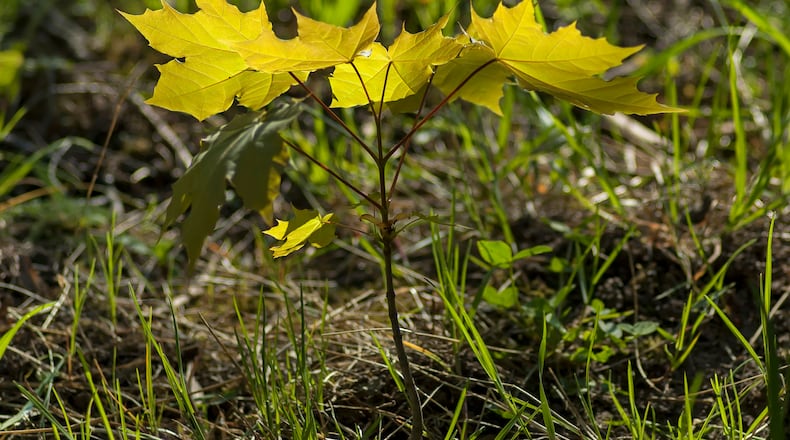That doesn’t mean that smaller spaces don’t matter or that they can’t contribute to the end goal: increasing habitat. That forgotten corner of a field or backyard, or even an ignored flower bed can make a difference, even this year.
En route
Pollinators are exceptionally mobile in their quests to keep the cycle of life turning. For example, Monarch butterflies participate in an annual 3,000-mile migration from Canada across the United States to Mexico. Honey bees can travel up to 3 miles and visit 50 to 100 flowers searching for nectar and pollen. No matter where you are in southwest Ohio, you’re both a Monarch’s migration route and within 3 miles from a beehive. Like everything in nature, quick access to required resources enhances survivability.
Making the shade
Once you’ve gotten rid of the amur honeysuckle and Bradford pears, consider Ohio Native trees. These are preferred by hundreds of moths, butterflies, and caterpillar species, and in turn, birds and other wildlife. Many can visually replace the expected ornamental non-native species we’ve become accustomed to. They might grow relatively slow, but they are hardy and often live longer than non-natives. Some species worth grabbing your shovel to plant include:
- River Birch: Hosts mourning cloak butterflies and several moths.
- Tuliptree: Draws a variety of butterflies and hummingbirds.
- Sugar Maple: Beautiful leaves in the fall and nectar for pollinators.
- Sassafras: A favorite host for Spicebush Swallowtail caterpillar
- Pawpaw: Offers tropical-tasting late-summer fruit and hosts the Zebra Swallowtail butterfly.
Note that some native tree species require both males and females to flower and fruit. Having a single isolated tree won’t deliver the desired results.
Pollinator pit stop
While planting trees can involve a time and space commitment, a pollinator garden can fit anywhere, even in containers. They can be planted anytime of the year other than the hottest part of summer. With some planning, you can enjoy native flower blooms from spring to fall - and so will your visiting butterflies, bees, and birds. It’s a great activity for kids of all ages.
Ground zero — the ground
The first step in any of these projects is ground prep.
In a nutshell, you’ll want to cut everything as low as possible, then cover the area you want to plant with a material that blocks 100% of the sunlight. That could be plastic, cardboard, or layers of newspaper. Leave the material in place for a few weeks to kill everything underneath, then another week just to be sure. When everything is brown, clear the dead vegetation as gently as possible. Don’t roto-till — that will give unwanted seeds a second shot to compete with the native plants.
Next, seed the area evenly with the seed mix you choose. Several outlets provide seed mixes native to and appropriate for Ohio listed at the bottom of this column. Note that if you intend to benefit Monarch butterflies, your seed mix must include milkweed.
Milkweed is the only plant that the Monarch butterfly lays eggs on. Plan for “at least 6 milkweed plants per small plot” said Charlie Holtz, writing on the Pheasants Forever website. “That will provide food for several monarch caterpillars since one caterpillar eats about one mature milkweed plant.” Then gently rake the seed into the top ¼ inch of soil. That’s it.
Low maintenance
There is even more good news about native plants: there’s virtually no maintenance. Having adapted to and been a part of the local environment for centuries, they’re suited to the conditions. This is their home. Other than making sure they get water at critical times starting out, if they’re in the soil, they’re good to grow. (Containers are obviously different and dependent on outside help.) Mowing or cutting back in late spring is probably all that’s needed.
Easy, not lazy
Once established, there is not much to be done, it can look to neighbors or others like the steward has abandoned the area. It can help aesthetically and possibly socially to make sure that area looks intentional and its function is identified. Landscaping timbers, rocks, or edging can help set the area off and even prevent non-natives from encroaching. Signs or placards can help signal the garden’s purpose and spread the word, and maybe inspire them to go create on their own.
What better way to celebrate the 55th anniversary of Earth Day?
Devin Meister is a local outdoors and wildlife enthusiast and has a blog called “Average Guy Outdoors.” He is an Ohio University graduate. Reach him at meister.devin@gmail.com.
Find plans
Ohio Native Plant Month
https://www.ohionativeplantmonth.org/plant-a-pollinator-garden
Pheasants Forever offers a free PDF download of instructions for organic site prep for any season: https://www.pfhabitatstore.com/resources/64/organic%20site%20preparation.pdf
Find seeds
https://www.pfhabitatstore.com/store/items/OH/
https://www.gardenia.net/guide/great-pollinator-plants-for-ohio
Resources
Register your pollinator garden to help Ohio studies and research https://www.ohionativeplantmonth.org/plant-a-pollinator-garden
Find Events
Marianist Environmental Education Center - Gardening with native plants hands-on workshop. April 26, 9 a.m - noon
Carolyn Kimes Tree Seedling Giveaway at 2nd Street Market - Free deciduous and coniferous tree seedlings, first come, first serve while supplies last. April 26, 9 a.m. to 3 p.m.
About the Author

